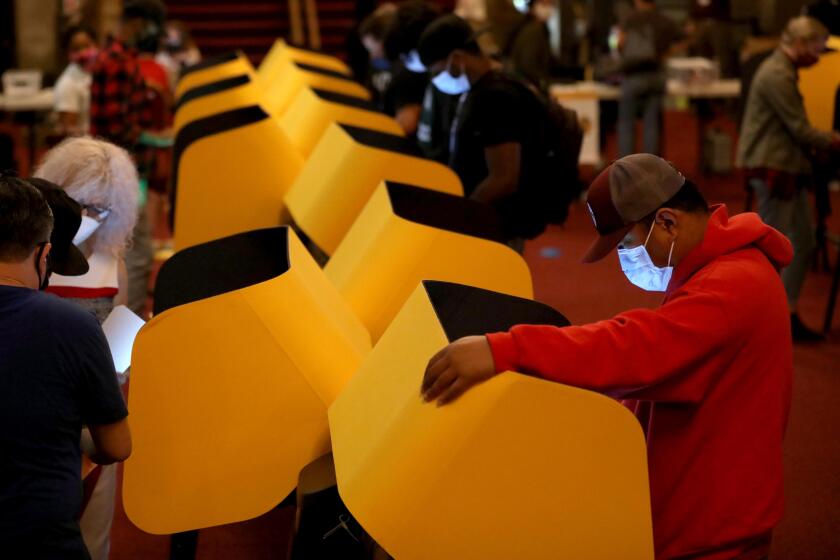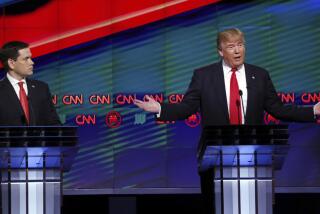Op-Ed: What broke the Republican Party?
- Share via
The Republican Party’s refusal to write a platform for 2020 was a watershed moment. Instead of issuing a traditional document, GOP leaders put out a memo essentially saying that their only goal was Donald Trump’s reelection. That move revealed the current Republican Party to be completely untethered from the one that governed during the Reagan and Bush administrations.
The post-election drama shows this break even more starkly. Trump has refused to concede the race, falsely claiming the election is rife with fraud. Republicans in Congress, including Senate Majority Leader Mitch McConnell, and other GOP officeholders have overwhelmingly gone along with this, refusing to acknowledge President-elect Joe Biden’s clear victory and supporting Trump’s baseless legal challenges. The few prominent Republicans who have called on Trump to admit defeat, for the most part, have “former” in their titles.
One could argue that these two camps represent different factions of the Republican Party, motivated by different ideological visions for the party or representing different interest groups competing for influence. But that’s not exactly right. In some ways, it makes more sense to see these as almost completely different Republican parties. The Republican Party of 2012 — the one that nominated Mitt Romney for president and recommended moderation and an embrace of immigrants after his loss — bears staggeringly little similarity to the Republican Party of 2020.
The GOP of the Reagan/Bush era, ranging from 1980 to 2008, broadly embraced economic conservatism (low taxes, reduced business regulation) and international engagement (robust trade, willingness to use force abroad) as governing philosophies. It also was generally a party that embraced democratic values —acknowledging the legitimacy of its opponents, demonstrating some forbearance in the use of its powers, supporting democratic elections, and so forth.
I don’t want to romanticize or oversimplify the GOP of that era. It was certainly riven by factions. Christian conservatives pushed the party toward more explicit regulation of people’s private behavior, especially on abortion and sexual orientation. Neoconservatives pushed the party toward aggressive and often disastrous foreign escapades.
What passed, what failed, who won, who lost and what does it mean for California?
Economic conservatives preached fiscal responsibility under Democratic administrations while running up record deficits when they were in power. Party demagogues such as Newt Gingrich smeared opponents and employed extreme tactics in governing. The party often looked the other way at bigotry in its own ranks, and its candidates sometimes used dog whistles to procure the white racist vote. And the party tirelessly fought internally over immigration, individual liberties and other key issues. But for the most part, it was a party that adhered to democratic values. Its internal fights played out in nomination contests and its fights with others played out in free and fair elections. (And the party even deposed Gingrich as House speaker.)
The GOP after the Obama administration was a very different entity. As a recent study from the V-Dem Institute found, the party itself hasn’t shifted much ideologically in recent years, but it has become far more illiberal. It has become less committed to pluralism and minority rights, while becoming more likely to demonize its opponents and encourage political violence. It is populist in its orientation, seeing virtually all conventions and traditions as inherently suspect. And its primary goal is the advancement of its leader.
What changed? There’s a good case to be made that race was at the center of this shift. White Americans, and especially white Republicans, increasingly identify themselves as belonging to a particular racial group, and many see that white identity as being under threat. Barack Obama’s presidency, as he suggests in his new memoir, magnified that threat in many conservative voters’ minds. The Democratic Party’s candidates weren’t just offering a different idea for governance; they were threatening the place of whites in the social order. Suddenly, the old rules of political engagement — which were fine for debating taxes and spending — weren’t good enough. When whites are told they are no longer the top racial group, it becomes a no-holds-barred competition, and good governance and democratic values get cast to the side.
We saw some of this in the rise of the tea party, which didn’t necessarily disagree with other Republicans on many policy issues but pushed for more confrontational tactics. We saw it in the government shutdown of 2013 and the threat to the government’s credit rating. And prior to Trump’s election, we saw it most distinctly in McConnell’s refusal to even hold hearings, much less a vote, for Obama’s Supreme Court nominee, Merrick Garland, along with his refusal to confirm many of Obama’s federal court appointments.
Trump is, of course, the embodiment of this new Republican Party and its illiberal orientation. He demonizes his opponents and, as he has been signaling since 2016, he does not acknowledge the legitimacy of any election he doesn’t win.
Some may wonder why the prominent Republicans who did endorse Biden and do recognize Biden’s victory seem to have so little influence on the party’s direction. The answer is simple. Those in the new GOP no longer see the Reagan-Bush Republicans as members of the same party.
Seth Masket is a professor of political science and director of the Center on American Politics at the University of Denver. He is the author of “Learning from Loss: The Democrats 2016-2020.”
More to Read
A cure for the common opinion
Get thought-provoking perspectives with our weekly newsletter.
You may occasionally receive promotional content from the Los Angeles Times.











